Ever since Fender launched Squier in the early ’80s, their secondary brand has supplied us with an almost overwhelming stream of well-priced Strat and Tele lookalikes and derivatives.
But Squier is not only about the Big Two. Fancy a Vista? Or a Starfire, a Stagemaster, or a ’51? You’ll find all those and plenty more in this timeline of the rest of Squier, from mashup experiments to superstrat shred-fests, from economical revivals to modders’ testbeds.
There’s bound to be something here worthy of your attention—and maybe even a few surprises hiding in plain sight and awaiting fresh discovery.
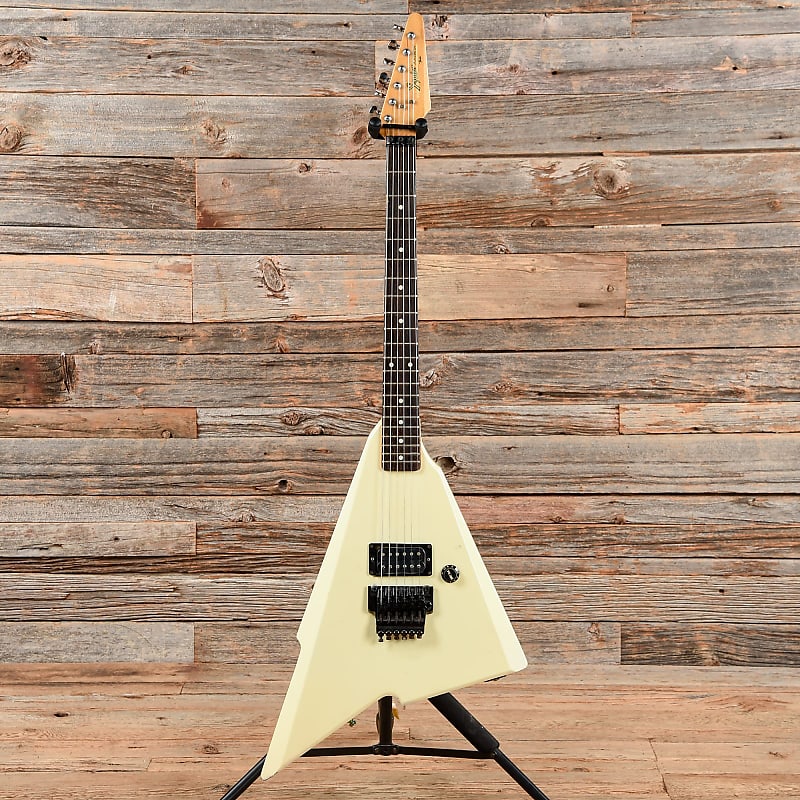
The first non-standard model to accompany the recently launched Squier brand’s array of Strat and Teles was a strange one—an attempt to compete with the contemporary vogue for unusual body shapes. The Katana, like all early Squiers, was made in Japan, and it’s a simplified take on a more expensive (and also shortlived) Fender-brand version. The wedge-shape basswood body has a single humbucker (at bridge), one control (volume), and a vibrato bridge/tailpiece, and the spear-like head recalls Fender’s obscure ’60s Swinger.

Fender adapted a line of superstrats made by Cort in Korea for Squier’s first superstrat series. There are five models, the first three (1989–93) with bolt-on necks: H.M.I (regular two-pivot vibrato and nut, HSS pickup layout); H.M.II (Floyd Rose locking vibrato and nut, HSS); and H.M.III (Floyd Rose, HSH); and then two (1990–93) with through-necks: H.M.IV (Floyd Rose, HSH) and H.M.V (as IV but figured body top). The Floyds switched from Licensed to Original versions in 1990/91.
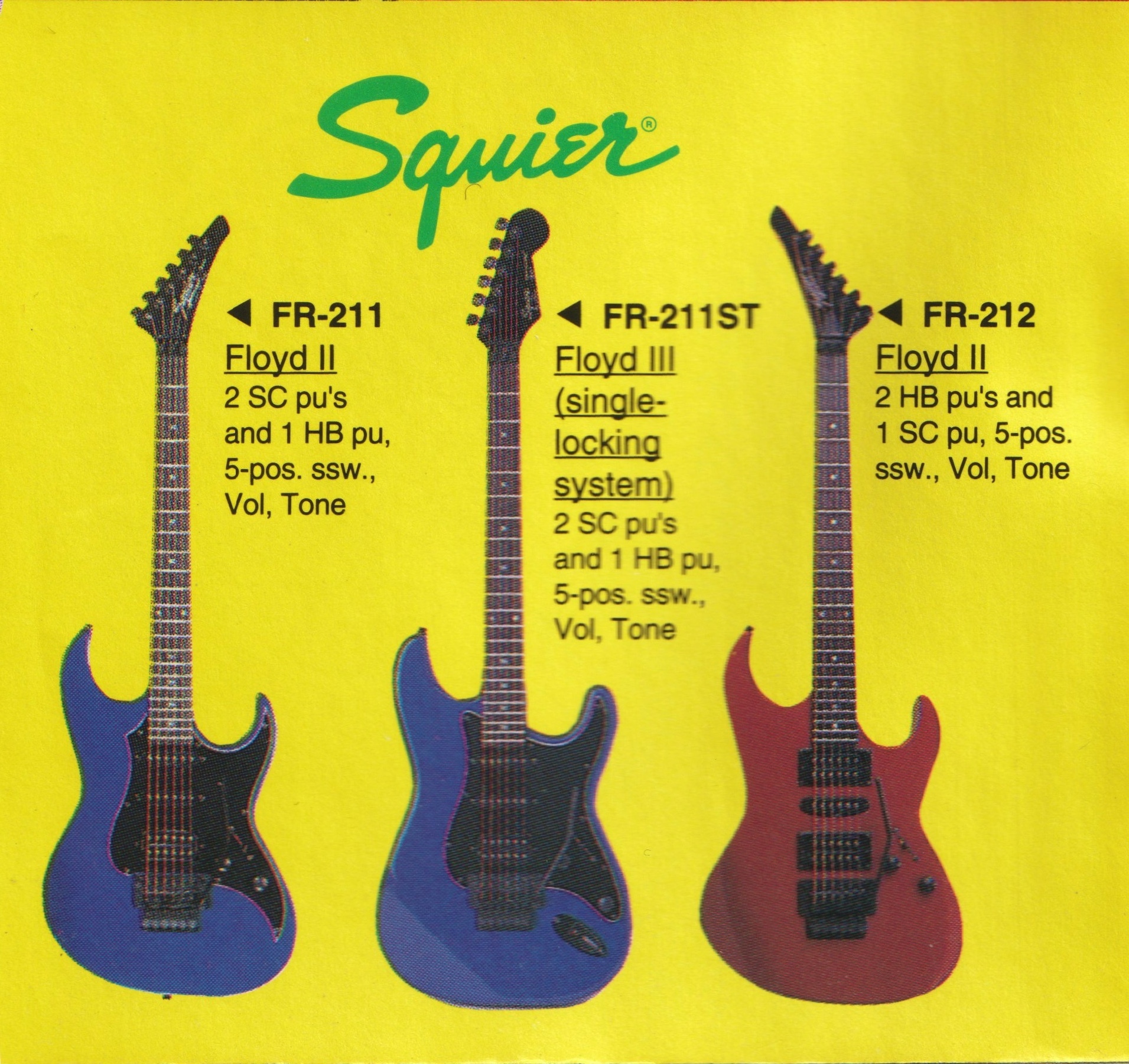
The superstrat theme of the H.M.s continues with a shortlived pair of Squier FR (Floyd Rose) models made in Korea. The two superstrats (there is also the Strat-shape FR-211ST) are easily ID’d visually: the FR-211 has a regular pointy headstock, the FR-212 a reverse version. Pickup layout is HSS for the 211, HSH on the 212, and the 212 is without a pickguard, its controls necessarily mounted on the body. Both have Floyd Rose II vibrato systems.
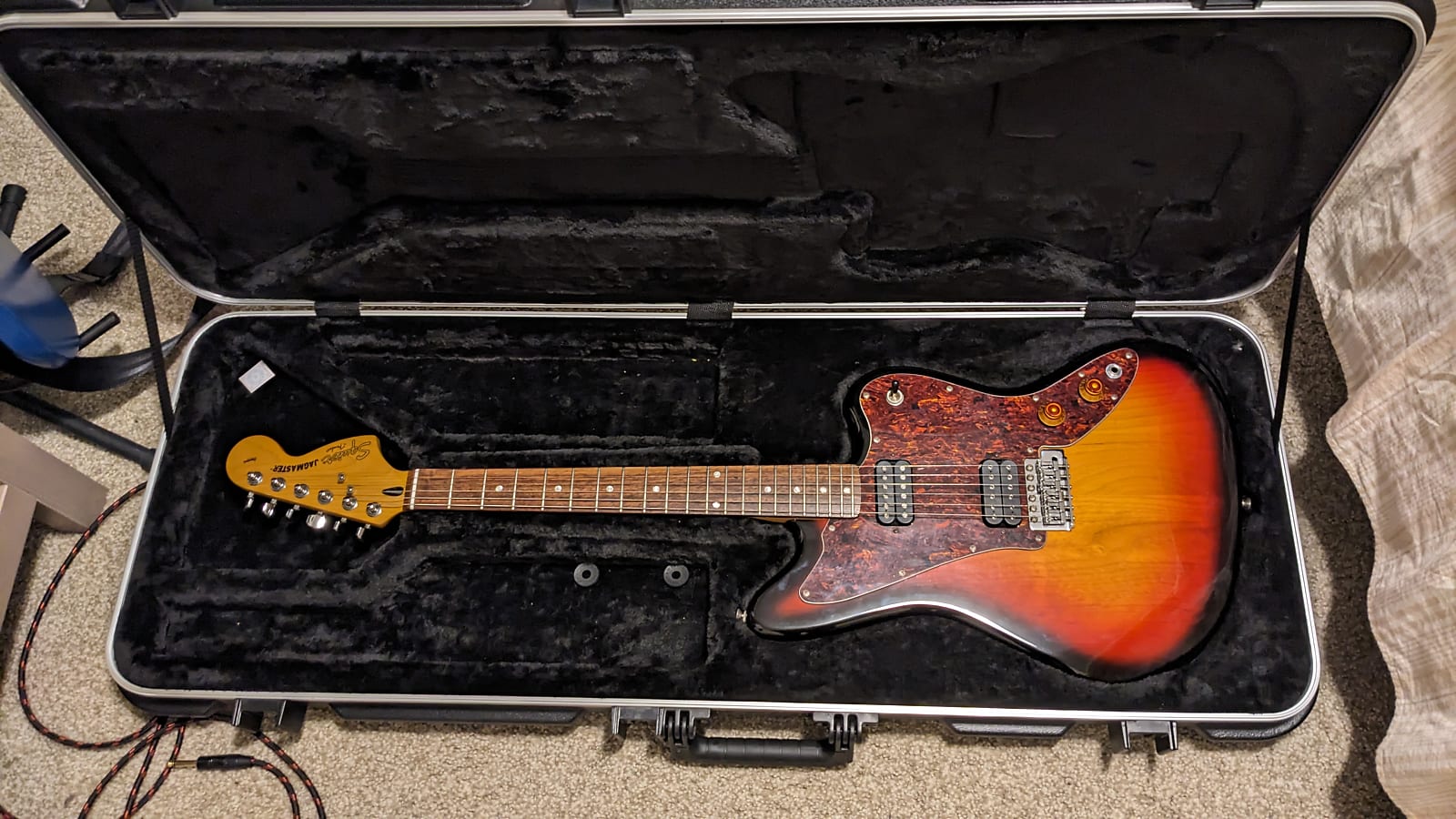
Squier’s bold new Vista series comprised this and the following Super-Sonic and Venus models, all Japan-made and with basswood bodies, maple necks, and rosewood boards. The Jagmaster (1996–98), based on a humbucker’d Jazzmaster played by Bush’s Gavin Rossdale, has two coverless humbuckers and simple volume, tone, and selector, with a Strat-style vibrato. Later Jagmaster models (2000–13) are China-made.
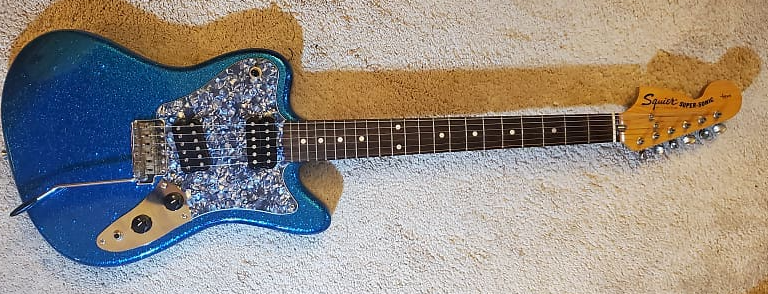
Another Japan-made Vista series model—its reverse body inspired by a photo of Hendrix playing an upside-down Jaguar—the Super-Sonic (1997–98) features two Dragster humbuckers (slanted at bridge), 24-inch scale and 22 frets, volume and tone on a Jag-style plate, selector, and a Strat-style vibrato. A later Super-Sonic (2020–current) is China-made for Squier’s Paranormal series with two Atomic humbuckers.
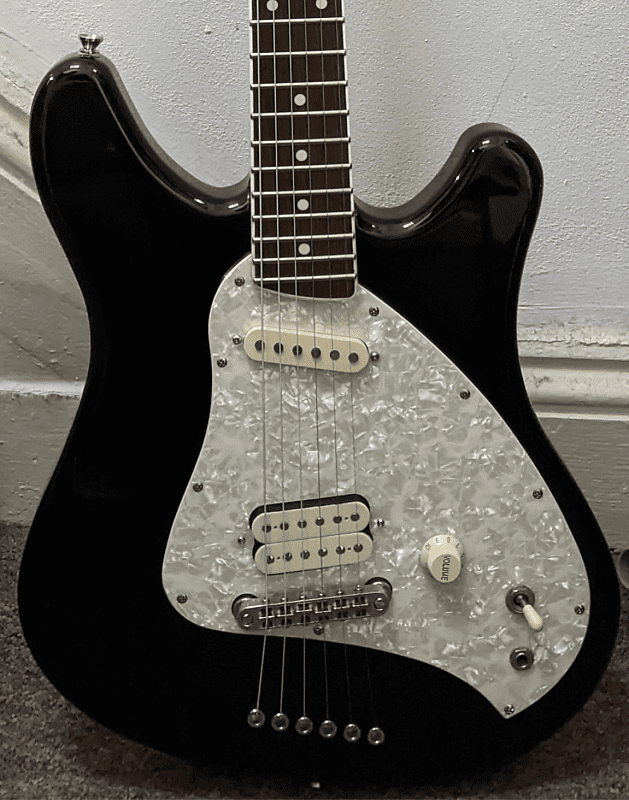
Rounding out the Vista series, the Venus was based on a guitar made by Mercury for Courtney Love. The double-cut body has an ST-Vintage single-coil (neck) and Dragster humbucker (bridge), 22 frets on a bound board, single volume and selector on a pearl-effect pickguard, and a Tune-o-matic style bridge with separate through-body stringing.
Also: Venus XII (1997–98) 12-string version with larger headstock, two Seymour Duncan SFEN12 split pickups, and a 12-saddle bridge with through-body stringing.
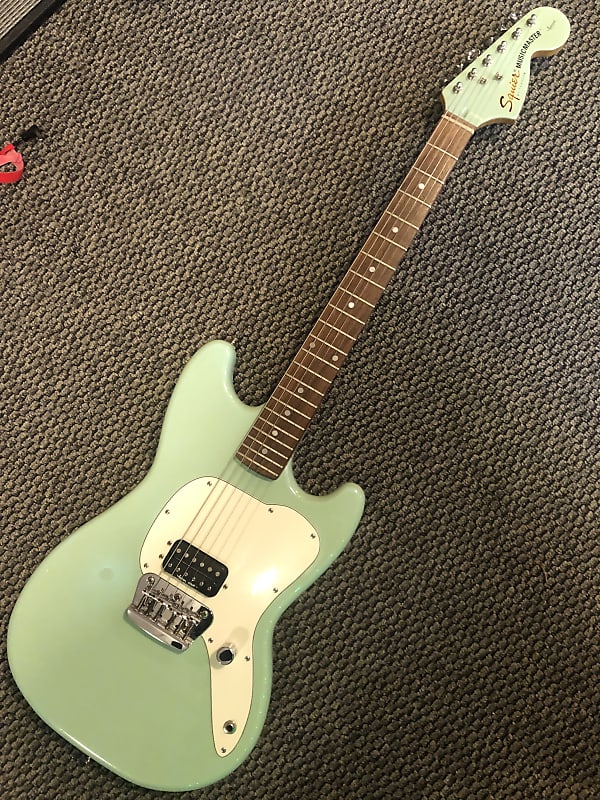
One further addition to the Vista series was this revised Fender oldie—China-made and therefore cheaper than the others. This Musicmaster has a single Vista Tone humbucker, 22 frets, 24.75-inch-scale, push-pull volume for coil-split, and through-body stringing.
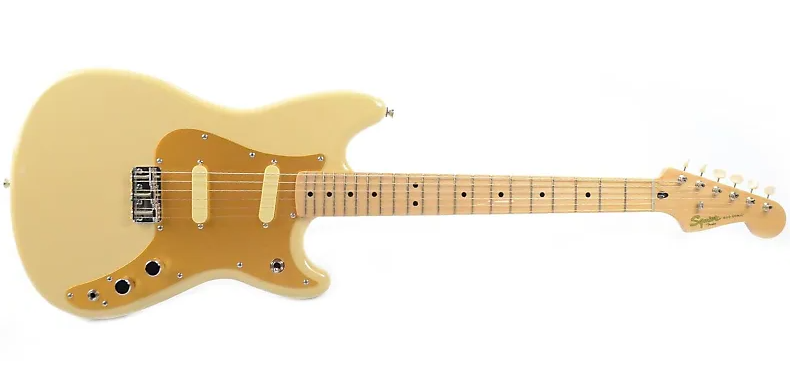
The cheapest Squier in the catalogue upon its launch in the late ’90s, this made-in-China Duo-Sonic (1997-98) sat in the brand’s bottom-rung Affinity series, with body material described simply as "hardwood." The maple neck and board have 20 frets on a short 22.7-inch scale, and the two single-coils are slanted. The later Duo-Sonic ‘50s (2008–11) is a 24-inch-scale 21-fret Classic Vibe version, also from China, with anodized pickguard.
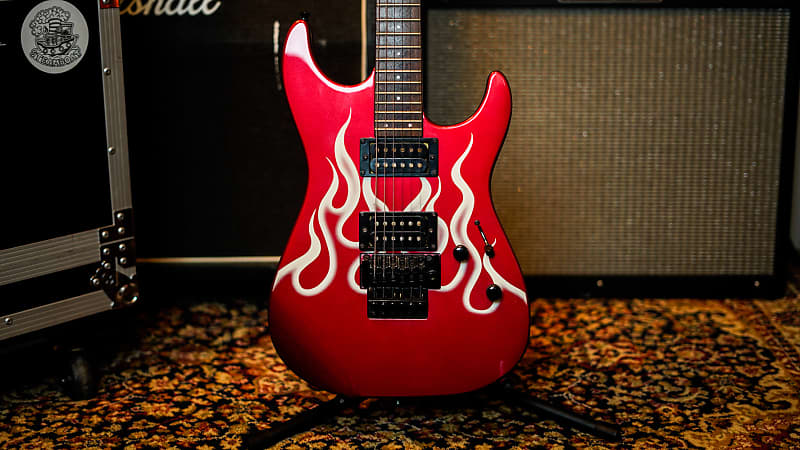
Another stab at Squier superstrats—with a change of model name along the way following a trademark dispute. Common features include superstrat-style bodies, reverse headstocks, maple necks and rosewood boards, two controls and selector, most are China or (some Showmasters) Indonesia manufacture, and almost always with a Floyd Rose vibrato system. There are four model groups, identifiable by their pickup layout, as follows.
** HH: Stagemaster HH (bolt-on neck: 22 frets 1999–2000; 24 frets 2000–02, renamed Showmaster HH 2002). Stagemaster HH Deluxe (through-neck, 24 frets 2000–02, renamed Showmaster HH Deluxe 2002). Stagemaster HH 7 FR/FT (seven-string version, FR has vibrato, FT hardtail 2000–02). Stagemaster/Showmaster Sub-Sonic Deluxe (27-inch scale baritone, hardtail, Korean-made 2001–02). Showmaster HH Rally Stripe (six-a-side head, hardtail with through-body stringing, striped finish 2003–05).
** HS: Showmaster HS Blackout (bolt-on neck, 24 frets, regular vibrato 2003–04).
** HSH: Stagemaster HSH (bolt-on neck: 22 frets 1999–2000; 24 frets 2000–02, renamed Showmaster HSH 2002–03). Stagemaster HSH Deluxe (through-neck, 24 frets 2000–02, renamed Showmaster HSH Deluxe 2002–03).
** HSS: Stagemaster HSS (bolt-on neck: 22 frets 1999–2000; 24 frets 2000–02, renamed Showmaster HSS 2002–03). Stagemaster HSS NLT (bolt-on neck, 22 frets, regular vibrato 2001–02, renamed Showmaster HSS NLT 2002–04).
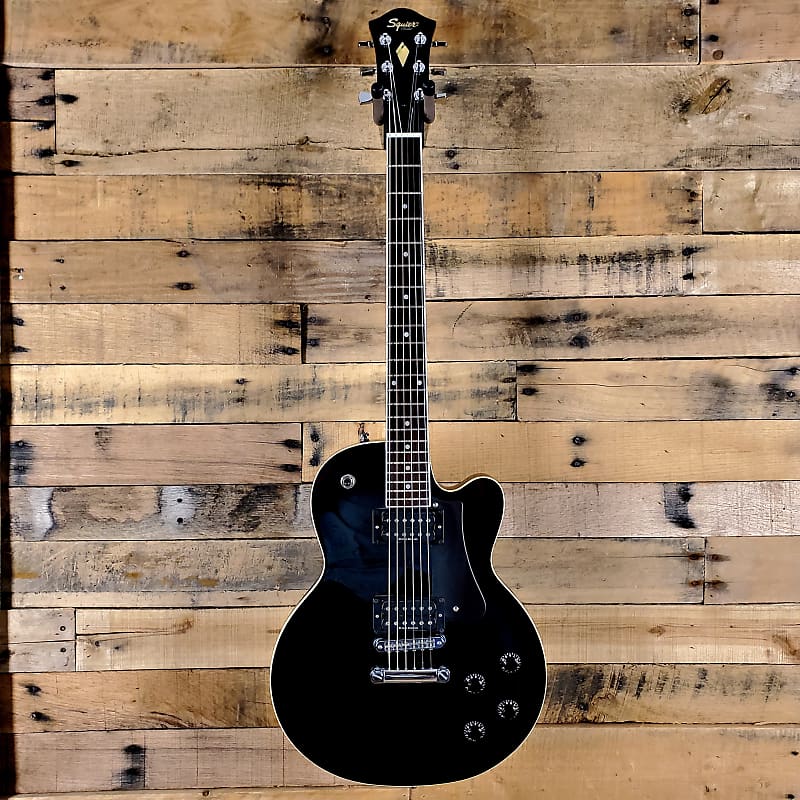
Squier’s Series 24 was a rebranded and reduced line based on Fender’s earlier Guild-related and Gibson-influenced DeArmond guitars. The series name came from the 24.75-inch scale-length. Each of these three single-cut solidbody M models has two humbuckers, 22-fret rosewood board, two volumes, two tones, and a selector, and a Tune-o-matic style bridge plus tailpiece. The made-in-Indonesia M-50 has an agathis body and nato bolt-on neck, while the M-70 and M-77 are Korean-made with two Duncan Designed humbuckers, bound mahogany body and set neck—the 70 with dot markers, the 77 with blocks and a figured maple top. See also: M-80 (2005–07).
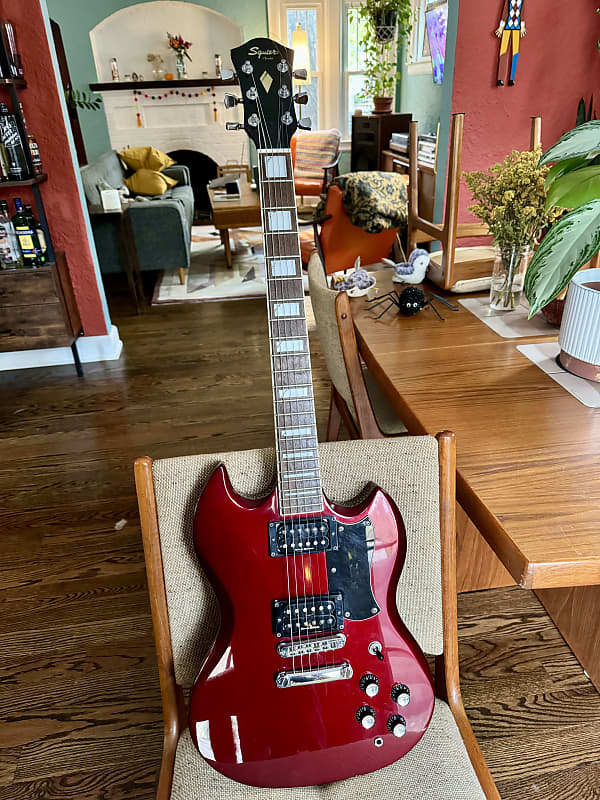
Two further Series 24 models, the double-cut solidbody S models: each has twin humbuckers, 22-fret rosewood board, two volumes, two tones, and a selector, and a Tune-o-matic style bridge plus tailpiece. The Indonesian S-65 has an agathis body, nato bolt-on neck, and dot markers, while the Korean S-73 has Duncan Designed humbuckers, a mahogany body and set neck, and block markers.
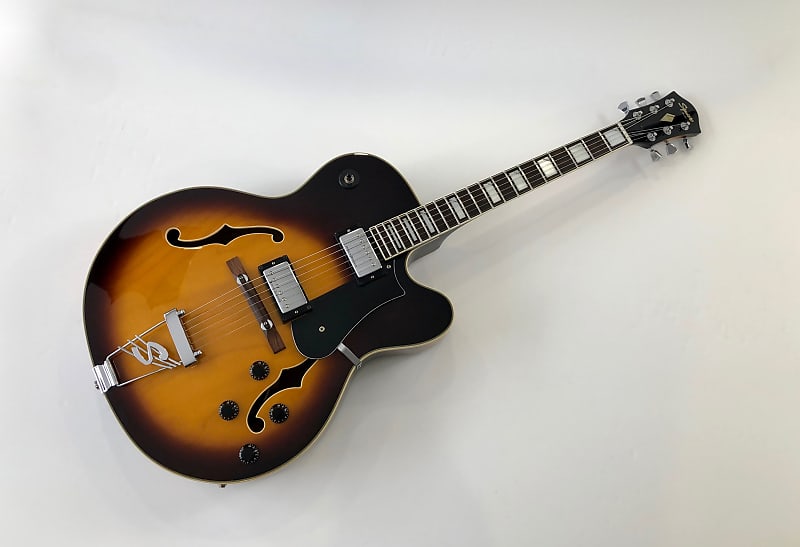
Two more from the Gibson/Guild-leaning Series 24, the made-in-Korea Starfire and X-155, each bear a pair of Duncan Designed humbuckers. The Starfire is a 335-style double-cut semi-hollow guitar with maple body, maple neck, and rosewood board, while the X-155 is a fully hollow jazz box with block markers and an S-for-Squier tailpiece.
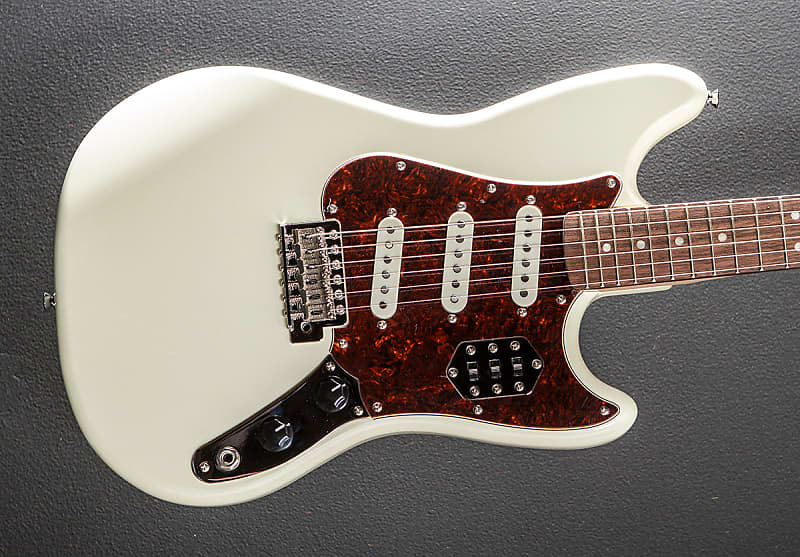
A circular story here: some of the ideas that underlined the Squier Vistas, especially the notion that it was cool to absorb the spirit and feel of older Fenders, informed "new" Fender-brand models such as 1998’s Toronado and Cyclone—both of which would in turn become Squier models. The first Squier Cyclone (2003–07), made-in-Indonesia, is a sort of modified Mustang, with 22 frets on a 24.75-inch scale, a humbucker (bridge) and angled single-coil (neck) on an alder body, and a Strat-style vibrato. The later China-made Paranormal-series Cyclone (2020–current) has three slanted Alnico single-coils and a Jag-style control plate with three pickup switches.
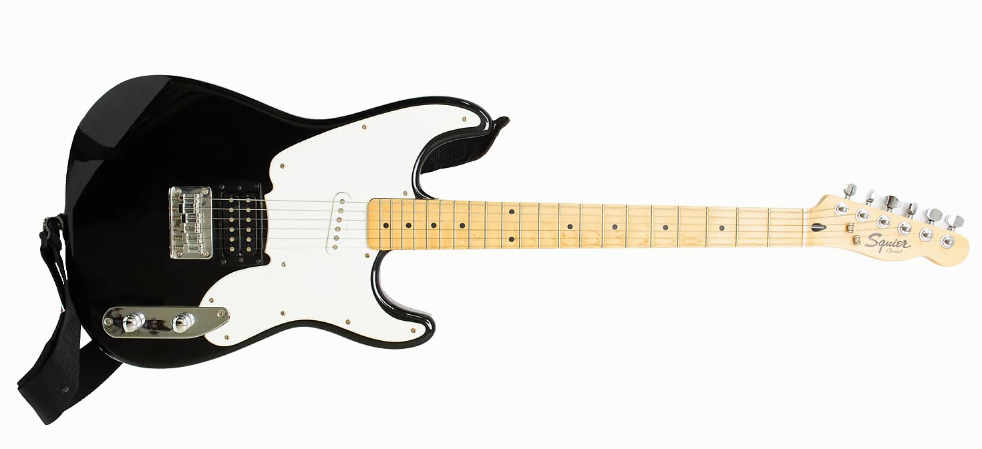
A guitar based on an early Precision Bass might sound like an awkward mashup, but the original cheap and modular ’51 (2004–07), made at Cort’s Indonesian factory, turned out to be widely popular with players who fancied some creative modding of their own. It does have some P-Bass vibe, including the general body shape, control panel, and pickguard, but adds a Tele neck with maple board, a humbucker at the bridge and slanted single-coil at the neck, and two knobs: one for volume, with push-pull coil-split, the other a three-way pickup rotary. The similar Vintage Modified ’51 (2013–16) is also Indonesia-made.
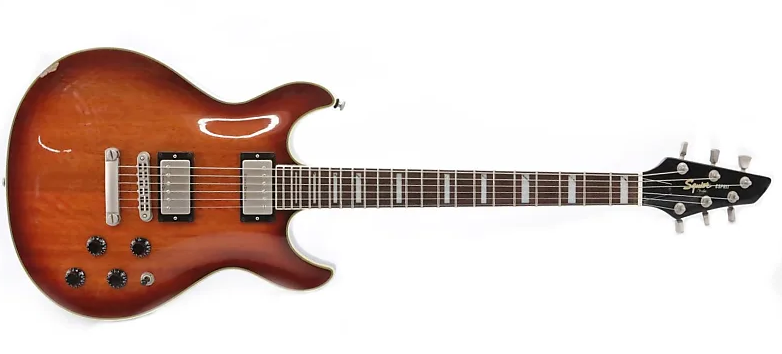
The Esprit was a Korean-made model in Squier’s Master series based on a shortlived Fender instrument from the mid ’80s. It has a double-cut semi-solid mahogany body, two Duncan Designed humbuckers, Gibson-style controls and bridge-plus-tailpiece, mahogany neck with slim-block markers in the rosewood board, no pickguard, and a three-a-side headstock.
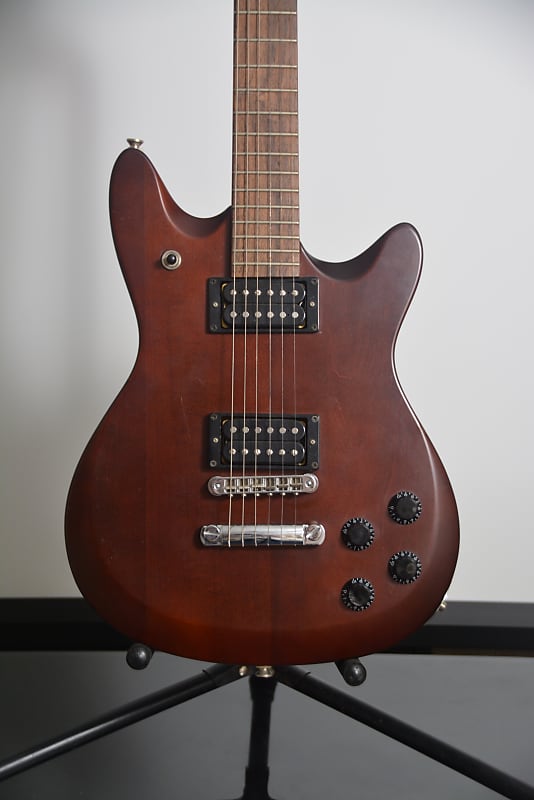
A pair of models to complete the Master series continued the Gibson-like vibe with double-cut basswood bodies, maple neck and rosewood board, twin humbuckers, two volumes, two tones, and a selector, and no pickguard. The Korean M-80 has a set neck, Duncan Designed ‘buckers, and slim-block markers, while the Indonesian M-80 Special, half the list-price of the M-80, has a bolt-on neck, regular pickups, and no position markers. See also: M-50 / M-70 / M-77 (2002–05).
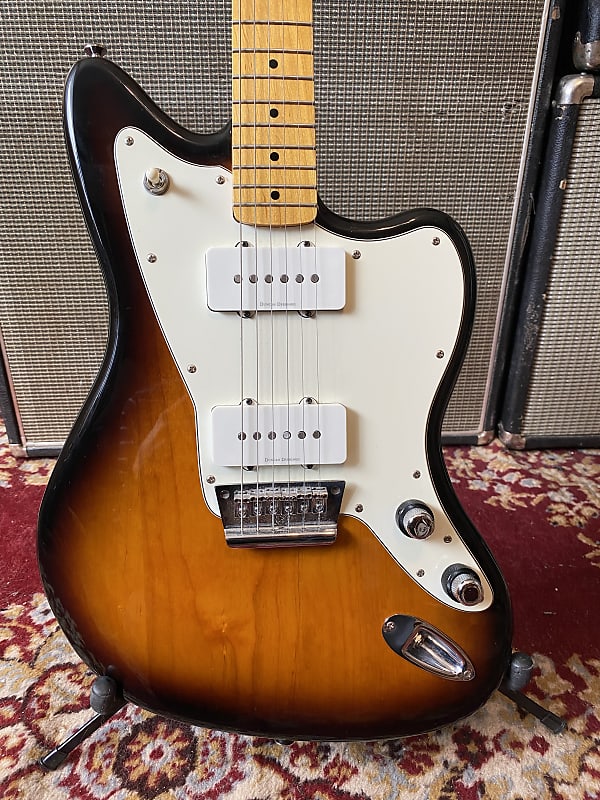
The first Squier Jazzmaster (2011–13) was made in Indonesia and sat in the Vintage Modified series. Yes, it’s a Jazzmaster, but… it has a top-loading hardtail bridge, the controls are limited to stacked volume and tone knobs and a selector, and there’s a maple neck and board. (Known in 2013 as Jazzmaster Special.) Later models: Jazzmaster (2013–18) A revised Vintage Modified version, more Vintage than Modified, with rosewood board and original-style controls and vibrato. Baritone Jazzmaster (2015–18) A down-tuner’s Vintage Modified Jazz with 30-inch scale. Deluxe Jazzmaster / With Tremolo (2016–17) Similarly priced to Vintage Modified models; with or without vibrato. Jazzmaster / Jazzmaster HH (2017–current) Affinity series budget model, with regular Jazz-type pickups or two humbuckers.
Active Jazzmaster HH / HH ST (2018–current) Contemporary series model with active ceramic humbuckers: bridge and tailpiece (2018–21) or vibrato (2022–current). ’60s Jazzmaster (2019–current) Classic Vibe replaces Vintage Modified with another period-feel Jazz. Mini Jazzmaster HH (2020–current) Scaled-down Jazz with two humbuckers. 40th Anniversary Jazzmaster Vintage / Gold Edition (2022–23) Squier’s birthday! Anodized guard, three-saddle bridge, anniversary neckplate—and gold-plated metalwork, of course, for the Gold Edition. Paranormal Jazzmaster XII (2023) 12-string Squier Jazzmaster with Electric XII-style head, 12-saddle bridge with through-body stringing.
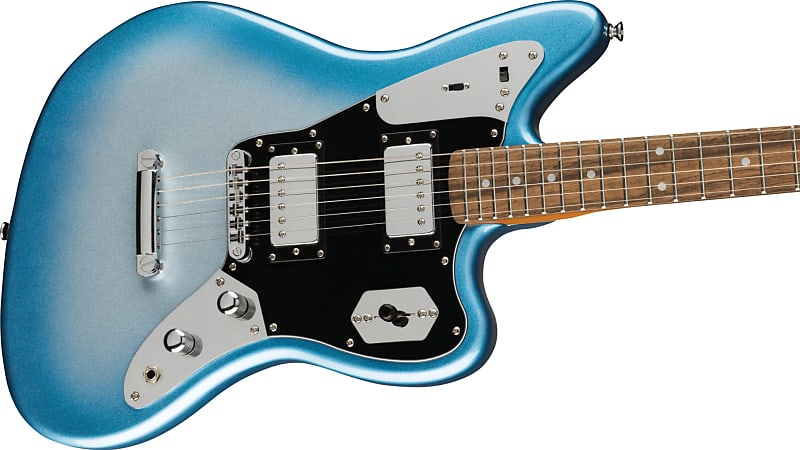
Like the equivalent Jazz, the first Squier Jag (Jaguar HH, 2011–13) was an Indonesia-made Vintage Modified model with top-loading hardtail bridge and stacked volume and tone knobs, but also it tossed two humbuckers into the mix.
Later models: Jaguar (2013–18) A revised Vintage Modified version leaning to vintage, with original-style controls and vibrato. ’70s Jaguar (2019–current) Classic Vibe replaces Vintage Modified with further period feel. Jaguar HH ST (2021–current) Contemporary series model with two Atomic humbuckers, coil-split and series/parallel switching, regular bridge and tailpiece.
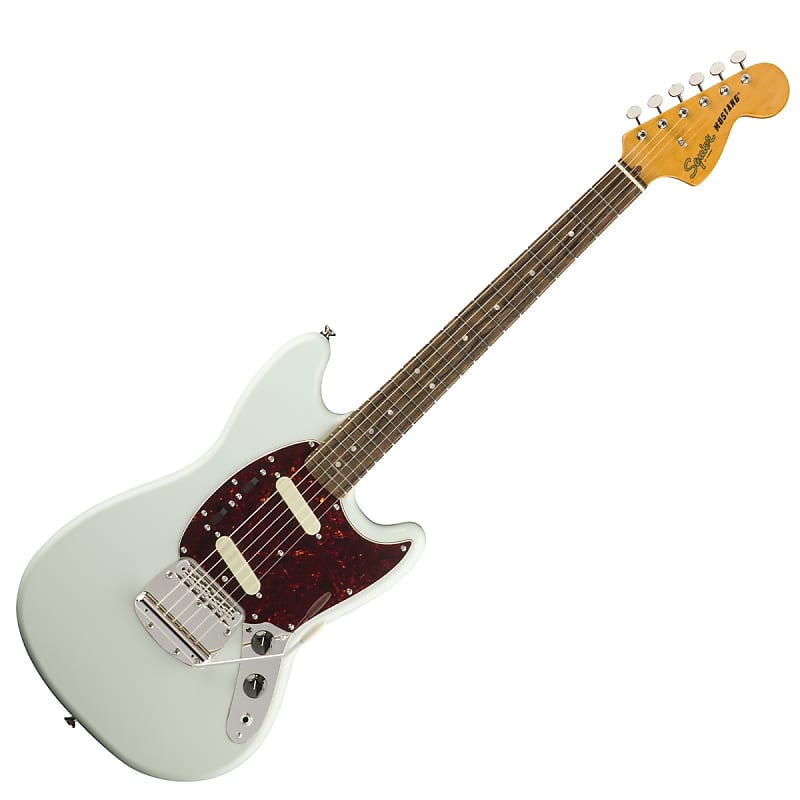
The Vintage Modified Mustang (2013–18) is another Squier modders’ favorite, coming straight from the Indonesian factory with basswood body, maple neck, 22 frets on a 24-inch scale, vibrato, and two slanted Duncan Designed single-coils.
Later models: Bullet Mustang HH (2017–22) Budget Mustang with humbuckers, hardtail bridge. ’60s Mustang (2019–current) Classic Vibe replaces earlier Vintage Modified model (some with Competition striped body). Mustang / Mustang HH (2023–current) Recent budget Sonic series here replaces the earlier Bullet model, now with single-coils or humbuckers.
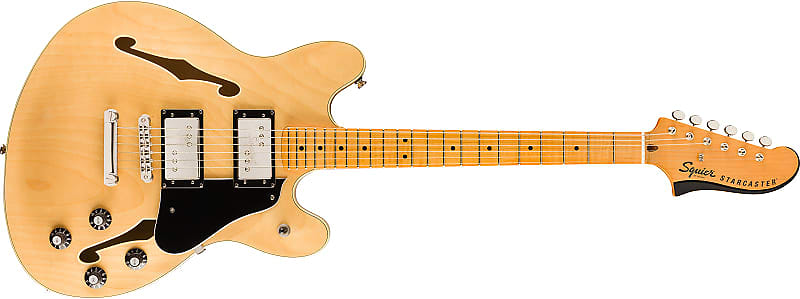
Reviving a Fender-brand attempt in the ’70s to rival Gibson’s dominance of the semi-solid market, Squier offered three price-points for its made-in-Indonesia new takes on the old Starcaster. The Contemporary series model has active humbuckers, the Classic Vibe series guitar has more of a vintage feel, with Fender Wide Ranging humbuckers like the original, and the budget Affinity series Starcaster has Standard humbuckers.
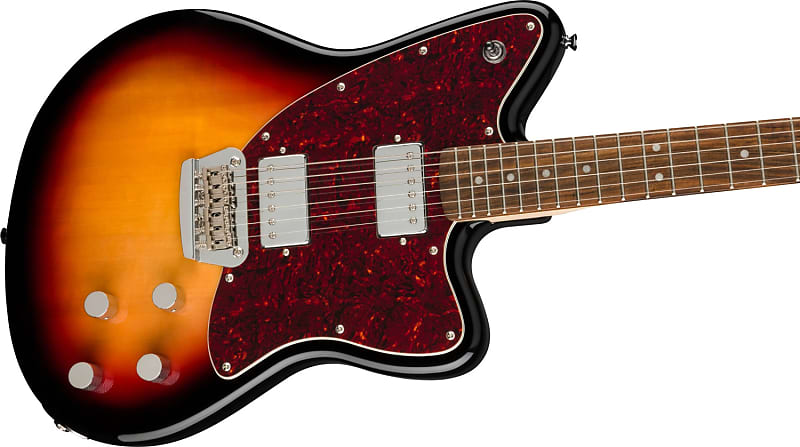
Again harking back to an earlier Fender design, this Toronado appeared in Squier’s mashup Paranormal series, made in China, boasting an offset poplar body with a pair of Atomic humbuckers, a maple neck and laurel board with Gibson-like 24.75-inch scale, and a hardtail bridge.
About the author: Tony Bacon writes about musical instruments, musicians, and music. His books include Squier Electrics and Legendary Guitars. Tony lives in Bristol, England. More info at tonybacon.co.uk.
